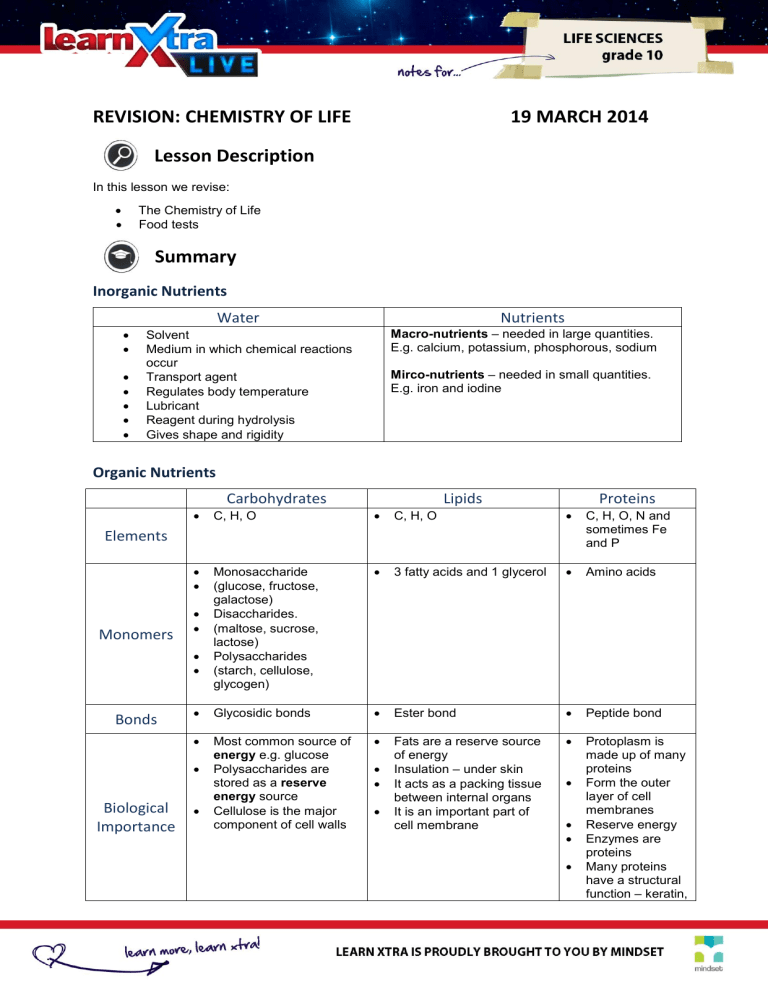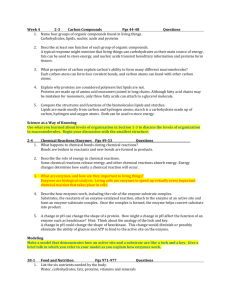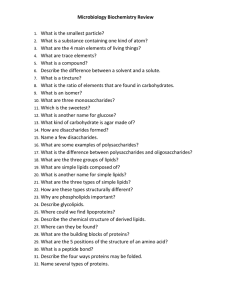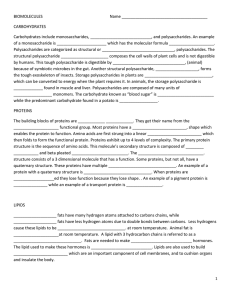
REVISION: CHEMISTRY OF LIFE 19 MARCH 2014 Lesson Description In this lesson we revise: The Chemistry of Life Food tests Summary Inorganic Nutrients Water Nutrients Macro-nutrients – needed in large quantities. E.g. calcium, potassium, phosphorous, sodium Solvent Medium in which chemical reactions occur Transport agent Regulates body temperature Lubricant Reagent during hydrolysis Gives shape and rigidity Mirco-nutrients – needed in small quantities. E.g. iron and iodine Organic Nutrients Carbohydrates Lipids Proteins C, H, O C, H, O C, H, O, N and sometimes Fe and P Monosaccharide (glucose, fructose, galactose) Disaccharides. (maltose, sucrose, lactose) Polysaccharides (starch, cellulose, glycogen) 3 fatty acids and 1 glycerol Amino acids Glycosidic bonds Ester bond Peptide bond Most common source of energy e.g. glucose Polysaccharides are stored as a reserve energy source Cellulose is the major component of cell walls Fats are a reserve source of energy Insulation – under skin It acts as a packing tissue between internal organs It is an important part of cell membrane Protoplasm is made up of many proteins Form the outer layer of cell membranes Reserve energy Enzymes are proteins Many proteins have a structural function – keratin, Elements Monomers Bonds Biological Importance Properties Monosaccharides and disaccharides are sweet to the taste, polysaccharides are NOT Monosaccharides and disaccharides dissolve in water, polysaccharides are NOT (osmotically inactive) They do not dissolve in water They do dissolve in or in alcohol Fats are in a solid form at room temperature Oils are in a liquid state at room temperature muscle, chromosomes, haemoglobin, collagen, bone Some hormones are proteins They are sensitive to changes in temperature and pH Enzymes Enzymes are organic catalysts, as they speed up and control chemical reactions in living organisms without being changed by the reaction (Taken from: http://waynesword.palomar.edu/molecu1.htm) They are proteins and therefore they: a) Are inactive at low temperatures, denatured (changes shape) at high 0 temperatures. Optimum temperature is 37 C b) Enzymes are sensitive to changes in pH (acidity and alkalinity) Enzymes are specific in that they will only work on one kind of substrate. E.g. maltase will break down maltose, because of the shape Vitamins Vitamins are essential for the normal growth, metabolism and development of the body Water -soluble vitamins – vitamins B and C. Absorbed by body together with water. Not stored in body and are excreted Fat-soluble vitamins – vitamins A, D, E and Absorbed when dissolved in fat. Stored in the body Food Tests To do food tests collect small samples of different food types which will serve as test material. If the test material is solid, rather grind it finely into small pieces The test mediums that indicate the presence of a certain substance are known as reagents Compound Glucose Starch sucrose Compound Protein Compound Lipids Example glucose powder/ grape juice/Energade/Oros starch powder/ bread/potato sucrose powder/table sugar Food tests for Carbohydrates Chemical Results obtained Benedict’s solution OR orange – red Fehling’s A and B Example egg white/beans/soup powder/milk powder Example peanuts/ olive oil Iodine blue-black Benedict’s solution OR Fehling’s A and B and HYDROCHLORIC ACID orange -red Food tests for Proteins Chemical Millons Reagent OR the Biuret test – copper sulphate and sodium hydroxide solution Food tests for Lipids Chemical ether / ethanol alcohol Results obtained purple/violet Results obtained translucent greasy spot Improve your Skills The Chemistry of Life Question 1 Study the diagram given and answer the questions on the answer sheet 1.1. Provide labels for the parts indicated A, B, C and F respectively. 1.2. What characteristic of enzymes is visible in the diagram? (4) (1) Question 2 The following table shows an analysis of the nutrients found in 100g portion of breakfast. The breakfast was made up of eggs, bread and butter. Use the information in the table to answer the following questions: 2.1 Name a vitamin deficiency disease that could result from a diet that consists mainly of bread. 2.2 Identify the food type that would be best for a person who suffers from night-blindness. Give a reason for your answer. This breakfast provides very little vitamin C. What food would you recommend to correct this? 2.3 Question 3 Match the carbohydrate compounds from the following list with the statements listed below. Some statements require more than one answer. Write the letter or letters only of the appropriate carbohydrate next to the question number. Letter to use Carbohydrate Letter to use A. glycogen F. fructose B. sucrose G. maltose C. glucose H. lactose D. starch I. cellulose E. galactose Statements: 1. 2. 3. 4. 5. 6. 7. 8. Carbohydrate storage carbohydrate found in liver and muscle tissue. cane sugar, also found in sugar beet. monosaccharide. the main carbohydrate in milk. disaccharide structural carbohydrate found in plant cells. combines with glucose to form lactose. insoluble in water. Food Tests Question 1 The pie charts below show the composition of three different organs from the body of an ox. The figures are percentages. Describe how you could demonstrate that a sample of heart contains protein. (6) Question 2 Milk provides a young mammal with all the nutrients it needs for its early growth and development. Milk contains proteins, carbohydrates and lipids. It also provides essential vitamins and minerals. The composition of milk, however, varies enormously. It varies from one species to another, from one individual to another, and even within a single individual. The graph below shows how the concentration of triglyceride in human milk changes as lactation (the period of milk production) progresses. The preamble states that ‘milk contains proteins, carbohydrates and lipids’. Draw up a table in which you state the tests used, the expected results and a conclusion of your results.



